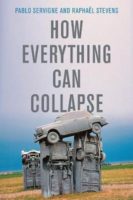 Ed. note: This is an excerpt from the English translation of the original French-language book How Everything Can Collapse: A Manual for our Times, by Pablo Servigne and Raphaël Stevens. Translated by Andrew Brown. This excerpt is published with permission of the publisher, Polity Books. You can find out more about the book here.
Ed. note: This is an excerpt from the English translation of the original French-language book How Everything Can Collapse: A Manual for our Times, by Pablo Servigne and Raphaël Stevens. Translated by Andrew Brown. This excerpt is published with permission of the publisher, Polity Books. You can find out more about the book here.
The birth of ‘collapsology’
Despite the high quality of some of the philosophical reflections on this topic, the debate on collapse (or ‘the end of a world’) fails because of the absence of factual arguments. It is stuck in imaginary or philosophical speculation without any real factual grounding. The books dealing with collapse are usually too specialized, restricted by their point of view or discipline (archaeology, economics, ecology, etc.), while more systematic discussions are full of gaps. Jared Diamond’s bestseller Collapse, for example, sticks to the archaeology, ecology and biogeography of ancient civilizations and does not address some of the essential questions of the current situation. As for other popular books, they usually tackle the question by adopting a survivalist position (telling you how to make bows and arrows, or how to find drinking water in a world plagued by fire and the sword), giving the reader all the thrills of watching a zombie movie.
Not only do we lack any real inventory – or better, any systematic analysis – of the planet’s economic and biophysical situation, but above all we lack an overview of what a collapse might look like, how it might be triggered and what it would imply in psychological, sociological and political terms for the present generations. We lack any real applied, transdisciplinary science of collapse.
We here propose, by drawing on information from many scattered works published across the world, to create the basics of what, with a certain self-deprecating irony, we have called ‘collapsology’ (from the Latin collapsus, ‘a fallen mass’). The goal is not to indulge in the mere scientific pleasure of accumulating knowledge but rather to shed light on what is happening and might happen to us, in other words, to give meaning to events. It is also and above all a way of treating the subject as seriously as possible so that we can calmly discuss the policies that need to be implemented.
The issues that emerge whenever the word ‘collapse’ is so much as mentioned are many and varied. What do we know about the overall state of our Earth? Or the state of our civilization? Is a collapse in stock market prices comparable to a collapse in biodiversity? Can the conjunction and perpetuation of ‘crises’ actually drag our civilization into an inescapable whirlpool? How far can all this go? How long will it last? Will we manage to maintain our democratic reflexes? Can we live more or less peacefully through a ‘civilized’ collapse? Will the outcome inevitably be entirely negative?
Immersing ourselves in the word ‘collapse’, understanding its subtleties and nuances, distinguishing between fact and fantasy – these are some of the objectives of collapsology. We need to take this notion apart and conjugate it in different tenses to give it texture, detail, and nuance: we need, in short, to make of it a living and fully operational concept. Whether we are thinking of Mayan civilization, the Roman Empire or more recently the USSR, history shows us that there are varying degrees of collapse, and that, even if there are constants, each case is unique.
Moreover, the world is not uniform. The question of ‘North-South relations’ needs to be considered in a new light. An average American consumes a lot more resources and energy than an average African. However, the consequences of global heating will be far worse in countries close to the equator – precisely those which have emitted the least gas and contributed least to the greenhouse effect. It seems obvious that the temporality of a collapse will not be linear and its geography will not be homogeneous.
So this isn’t a book that is meant to scare you. We will not be dealing with millenarian eschatology, nor with the potential astrophysical or tectonic events that could trigger a mass extinction of species of the kind the Earth saw sixty-five million years ago. We have enough to deal with when we look at what humans can do all by themselves. Nor is this a pessimistic book that doesn’t believe in the future, nor a ‘positive’ book that minimizes the problem by providing ‘solutions’ in the last chapter. It’s a book that attempts lucidly to set out the facts, to ask relevant questions, and to assemble a toolbox which will make it possible to grasp the subject other than through Hollywood disaster movies, the Mayan calendar or ‘techno-bliss’. We are not just presenting a ‘top ten’ of the century’s bad news stories, we are mainly proposing a theoretical framework for hearing about, understanding and welcoming all the small-scale initiatives that are already facing up to the ‘post-carbon’ world, initiatives that are emerging at breakneck speed.





